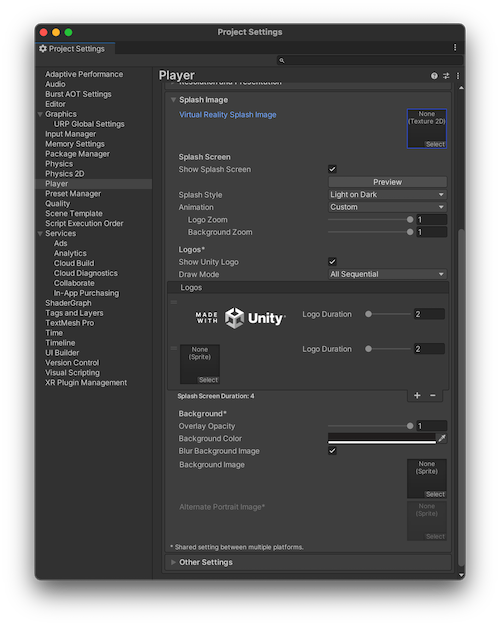启动画面播放器 (Splash Image Player) 设置
配置应用程序启动时显示的启动画面。
使用 Splash Image Player 设置可自定义或禁用 Unity 标志、添加您自己的标志或完全禁用启动画面。
要访问 Splash Image Player 设置,请前往编辑 (Edit) > 项目设置 (Project Settings) > 播放器 (Player) > 启动画面 (Splash Image)。此外,可使用 SplashScreen API 来控制启动画面设置。
注意:在所有平台上,Unity 启动画面会在应用程序的第一个场景在后台加载时显示。自定义启动画面或动画的出现可能需要更长的时间,因为 Unity 必须先加载引擎和第一个场景,然后才能显示自定义启动画面。

虚拟现实启动画面 (Virtual Reality Splash Image)
设置用于使用虚拟现实的应用程序的图像。图像必须是 2D Texture。
启动画面 (Splash Screen)
显示启动画面的设置。
| 设置 | 描述 | |
|---|---|---|
| Show Splash Screen | 启用或禁用启动画面。 | |
| Preview | 在 Game 视图中查看启动画面的预览。预览反映了 Game 视图的分辨率和宽高比。 | |
| Splash Style | 选择 Unity 标志的颜色样式。 | |
| Light on Dark | Unity 标志的浅色版本,最适合在深色背景上显示。这是默认设置。 | |
| Dark on Light | Unity 标志的深色版本,最适合在浅色背景上显示。 | |
| Animation | 自定义启动画面在屏幕上的显示和消失方式。 | |
| Static | 不出现动画。 | |
| Dolly | 标志和背景可以变焦以创建视觉推拉变焦效果。这是默认设置。 | |
| Custom | 配置背景和标志变焦以修改推拉变焦效果。 | |
| Logo Zoom | 在标志动画的总持续时间结束时,设置标志的目标缩放(从 0 到 1)。 仅当 Animation 为 Custom 时,此设置才可用。 |
|
| Background Zoom | 启动画面动画总持续时间结束时背景的目标缩放(从 0 到 1)。 仅当 Animation 为 Custom 时,此设置才可用。 |
|
徽标 (Logos)
用于在启动画面中自定义徽标的设置。
| 设置 | 描述 | |
|---|---|---|
| Show Unity Logo | 默认启用。禁用此选项可从启动画面中删除 Unity 徽标。 | |
| Draw Mode | 选择徽标在启动屏幕上显示的顺序。 仅当启用了 Show Unity Logo 时,此设置才可用。 |
|
| Unity Logo Below | 在 Logos 列表中所有徽标下方显示 Unity 徽标。 | |
| All Sequential | 按顺序显示 Unity 徽标以及 Logos 列表中的所有徽标。 | |
| Logos | 选择要包含在启动画面上的徽标。每个徽标必须是 Sprite Asset。 执行以下操作以更新徽标:
|
|
| Logo Duration | 设置每个 Sprite Asset 在屏幕上显示的时间长度。应使用介于 2 秒和 10 秒之间的值。 仅当 Draw Mode 为 All Sequential 时,此设置才可用。 |
|
| Splash Screen Duration | 显示启动画面序列的总持续时间,以秒为单位。这是所有徽标持续时间的总和加上 0.5 秒的淡出时间。 注意:如果第一个场景尚未准备好播放,应用程序的启动画面可能会显示更长的时间。在这种情况下,启动画面仅显示背景图像或颜色,然后在第一个场景准备好播放时淡出。 |
|
背景 (Background)
自定义设置应用程序启动画面的背景。
| 设置 | 描述 |
|---|---|
| Overlay Opacity | 调整覆盖层的不透明度,使徽标突出显示。这会影响徽标的背景颜色和图像颜色,具体取决于 Splash Style。 将不透明度设置为较小的值来减弱此效果。您也可以通过将其设置为 0 来禁用该效果。例如,如果 Splash Style 为 Light on Dark,并且使用白色背景,那么当 Overlay Opacity 为 1 时背景变为灰色,设置为 0 时背景变为白色。 注意:Overlay Opacity 设置对 Background Color 的显示有影响,可能与指定的颜色不匹配。 |
| Background Color | 设置启动画面的颜色。如果未设置 Background Image,Unity 会使用此颜色。 注意:Overlay Opacity 设置对 Background Color 的显示有影响,可能与指定的颜色不匹配。 注意:在 Android 上,Unity 还使用此颜色隐藏 Android 12+ 设备上显示的默认自动启动画面。即使设置了 Background Image,也会发生这种情况,因此请确保此颜色与 Background Image 匹配。 |
| Blur Background Image | 启用此设置可为设置的背景图像创造模糊效果。如果禁用此设置,则会显示没有模糊效果的背景图像。 |
| Background Image | 设置对要用作背景的精灵的引用。Unity 会调整背景图像来使其填满屏幕。它会均匀缩放图像直到适合屏幕的宽度和高度。这意味着图像的某些部分可能会以一定宽高比延伸到屏幕边缘之外。要调整背景图像对宽高比的响应,请在 Sprite Editor 中更改精灵的 Position 值。 注意:启动画面背景不支持 HDR 图像。避免将 HDR 图像格式(例如 RGBA16)用于启动画面背景图像。 |
| Alternate Portrait Image | 设置用于纵向宽高比的替代图像(例如,纵向模式下的移动设备)。如果未指定 Alternate Portrait Image 精灵,那么 Unity Editor 会将指定为 Background Image 的精灵用于纵向和横向模式。 可以在 Sprite Editor 中调整精灵的位置和尺寸,从而控制启动画面上背景图像的宽高比和位置。 |
其他资源
PlayerSettingsSplashScreen